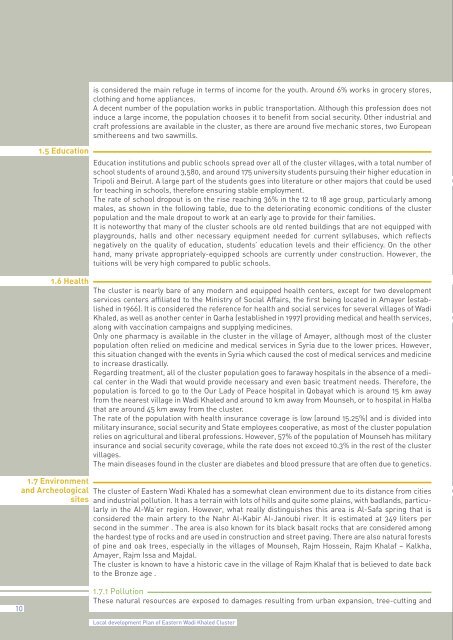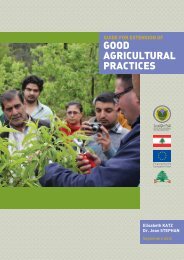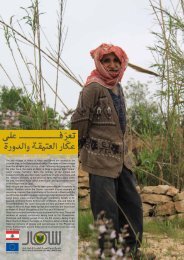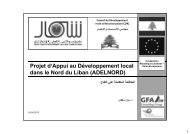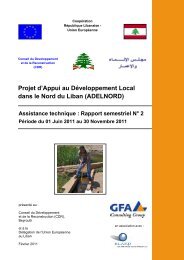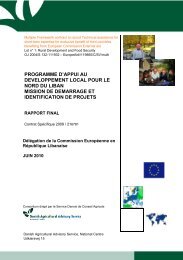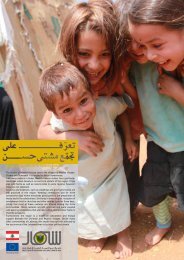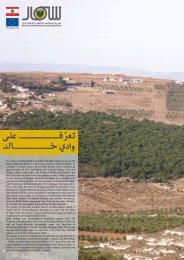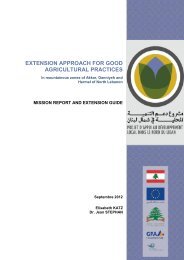Eastern Wadi Khaled - ADELNORD
Eastern Wadi Khaled - ADELNORD
Eastern Wadi Khaled - ADELNORD
- No tags were found...
Create successful ePaper yourself
Turn your PDF publications into a flip-book with our unique Google optimized e-Paper software.
10is considered the main refuge in terms of income for the youth. Around 6% works in grocery stores,clothing and home appliances.A decent number of the population works in public transportation. Although this profession does notinduce a large income, the population chooses it to benefit from social security. Other industrial andcraft professions are available in the cluster, as there are around five mechanic stores, two Europeansmithereens and two sawmills.1.5 EducationEducation institutions and public schools spread over all of the cluster villages, with a total number ofschool students of around 3,580, and around 175 university students pursuing their higher education inTripoli and Beirut. A large part of the students goes into literature or other majors that could be usedfor teaching in schools, therefore ensuring stable employment.The rate of school dropout is on the rise reaching 36% in the 12 to 18 age group, particularly amongmales, as shown in the following table, due to the deteriorating economic conditions of the clusterpopulation and the male dropout to work at an early age to provide for their families.It is noteworthy that many of the cluster schools are old rented buildings that are not equipped withplaygrounds, halls and other necessary equipment needed for current syllabuses, which reflectsnegatively on the quality of education, students’ education levels and their efficiency. On the otherhand, many private appropriately-equipped schools are currently under construction. However, thetuitions will be very high compared to public schools.1.6 Health1.7 Environmentand ArcheologicalsitesThe cluster is nearly bare of any modern and equipped health centers, except for two developmentservices centers affiliated to the Ministry of Social Affairs, the first being located in Amayer (establishedin 1966). It is considered the reference for health and social services for several villages of <strong>Wadi</strong><strong>Khaled</strong>, as well as another center in Qarha (established in 1997) providing medical and health services,along with vaccination campaigns and supplying medicines.Only one pharmacy is available in the cluster in the village of Amayer, although most of the clusterpopulation often relied on medicine and medical services in Syria due to the lower prices. However,this situation changed with the events in Syria which caused the cost of medical services and medicineto increase drastically.Regarding treatment, all of the cluster population goes to faraway hospitals in the absence of a medicalcenter in the <strong>Wadi</strong> that would provide necessary and even basic treatment needs. Therefore, thepopulation is forced to go to the Our Lady of Peace hospital in Qobayat which is around 15 km awayfrom the nearest village in <strong>Wadi</strong> <strong>Khaled</strong> and around 10 km away from Mounseh, or to hospital in Halbathat are around 45 km away from the cluster.The rate of the population with health insurance coverage is low (around 15.25%) and is divided intomilitary insurance, social security and State employees cooperative, as most of the cluster populationrelies on agricultural and liberal professions. However, 57% of the population of Mounseh has militaryinsurance and social security coverage, while the rate does not exceed 10.3% in the rest of the clustervillages.The main diseases found in the cluster are diabetes and blood pressure that are often due to genetics.The cluster of <strong>Eastern</strong> <strong>Wadi</strong> <strong>Khaled</strong> has a somewhat clean environment due to its distance from citiesand industrial pollution. It has a terrain with lots of hills and quite some plains, with badlands, particularlyin the Al-Wa’er region. However, what really distinguishes this area is Al-Safa spring that isconsidered the main artery to the Nahr Al-Kabir Al-Janoubi river. It is estimated at 349 liters persecond in the summer . The area is also known for its black basalt rocks that are considered amongthe hardest type of rocks and are used in construction and street paving. There are also natural forestsof pine and oak trees, especially in the villages of Mounseh, Rajm Hossein, Rajm Khalaf – Kalkha,Amayer, Rajm Issa and Majdal.The cluster is known to have a historic cave in the village of Rajm Khalaf that is believed to date backto the Bronze age .1.7.1 PollutionThese natural resources are exposed to damages resulting from urban expansion, tree-cutting andLocal development Plan of <strong>Eastern</strong> <strong>Wadi</strong> <strong>Khaled</strong> Cluster1.8 Infrastructuresthe absence of sewage networks. Therefore, most of the cluster population turns to disposing of bilgewater either in inappropriate septic tanks or in natural pits or by directing it to dry groundwater or thecanals of winter rains, leading these waters to leak to the core of the earth, polluting Al-Safa spring,considering as its flow has diminished considerably during the summer as a result of the wells thatwere created without permits and are estimated to around 500 wells, mostly private ones.The absence of municipalities and the priority given to economic living issues in the cluster has madethe exploit of natural resources an element that is worsening the environmental problems, reflectingin the increase of the pollution of groundwater and its random consumption, along with the pollutionof Al-Kabir Al-Janoubi River.1.7.2 WasteThe waste problem is an issue for the entire cluster and its surroundings as solid waste is found inthe forests or in the winter rain canals or burned in the wilderness, thus often leading to obnoxioussmells, which in turn spread pulmonary diseases. The number of asthmatics in the cluster is around187 patients.In the village of Mounseh, things are slightly different due to the presence of a municipality. Trash iscollected in special bins, then transported far from the village and burned, twice a week. The averagetrash volume for a family of six is estimated at around 5 kg/day, the equivalent of 11.5 tons/day for thecluster. Some of the <strong>Wadi</strong> <strong>Khaled</strong> families depend on a trash collection company “Sharikat Al-AmanaAl-Arabiya” for a monthly fee of LBP 15,000. The trash is transported to the Srar dump.The cluster of <strong>Eastern</strong> <strong>Wadi</strong> <strong>Khaled</strong> lacks all kinds of infrastructure, be they for sewage systems ofwater networks.1.8.1 WaterThe area of <strong>Eastern</strong> <strong>Wadi</strong> <strong>Khaled</strong> completely lacks a water network connected to the houses, in spiteof the presence of a spring. It is to be noted that there is an old water company dating back to 1960that is out of service. Furthermore, a project was initiated in 1997 by the Council for Developmentand Reconstruction, linking Al-Safa spring to all the surrounding villages. However, this project wascompletely suspended for reasons that are unknown to the population, the only accomplished partsbeing the main pump and the main network but lacking the second network of water supply linkingthe network to the households.Regarding Mounseh, the village lacks a drinking water network, although the Council for Developmentand Reconstruction has created a water network in 2002. However, no water has been pumped to thisday as the pumps require special electrical transformers that have not been installed yet.The population resorts to providing water for household consumption either by artesian wells that arenumerous and randomly-dug or by tanks, which adds burdens to the families.As for drinking water, the population relies on Al-Safa spring, artesian wells or on purchasing mineralwater. Most of the population relies on water from the wells for drinking and household consumption,although this water is often non-drinkable, either due to its pollution or its calcareous nature. InMounseh, however, the population gets its water supply in tanks from Al-Sabeh spring in Akroum andfrom Al-Safa spring.1.8.2 Roads in the clusterThe main roads linking the cluster villages together are in terrible condition, as they require rehabilitation,since they have been lacking maintenance since they were paved in 1998. They are filled withholes as a result of the absence of canals for storm water on the sides of the roads, which worsensthe situation whenever it rains.Back roads are in even worse condition, considering that they are narrow and barely paved, except forthe roads in Mounseh and Qarha, where most of them were rehabilitated at the expense of the municipalityof Mounseh and active political parties of Qarha.Nevertheless, to this day, several roads remain unpaved in all of the villages, where a number ofagricultural lands and lands fit for construction is not being exploited due to difficulty of access. It isnoteworthy that some of these roads will be rehabilitated through the project of local development inthe north, funded by the European Union and run by the Council for Development and Reconstruction.Elaborated in the framework of <strong>ADELNORD</strong> Project, funded by the EU, executed by ESFD/ CDR


